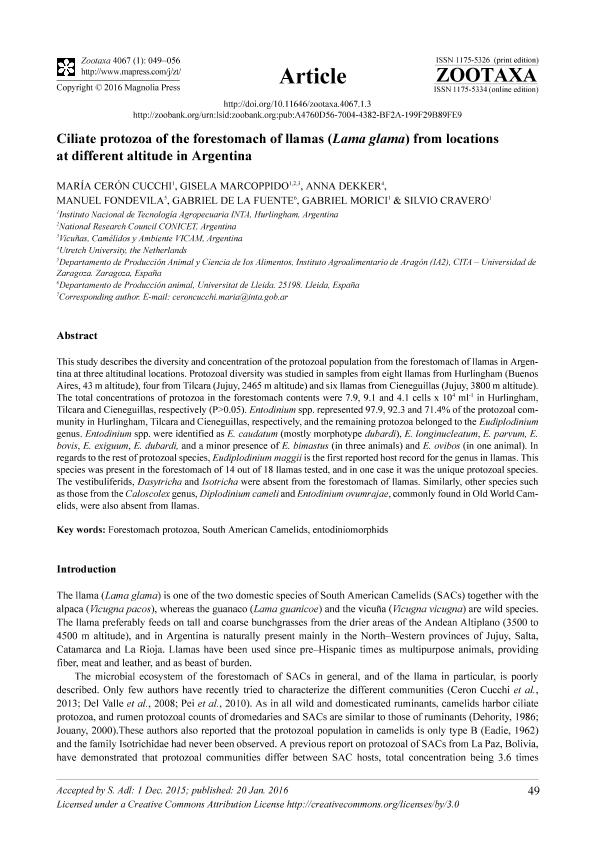Artículo
Ciliate protozoa of the forestomach of llamas (Lama glama) from locations at different altitude in Argentina
Cerón Cucchi, María Esperanza ; Marcoppido, Gisela Ariana
; Marcoppido, Gisela Ariana ; Dekker, Anna; Fondevila, Manuel; de la Fuente, Gabriel; Morici, Gabriel; Cravero, Silvio Lorenzo Pedro
; Dekker, Anna; Fondevila, Manuel; de la Fuente, Gabriel; Morici, Gabriel; Cravero, Silvio Lorenzo Pedro
 ; Marcoppido, Gisela Ariana
; Marcoppido, Gisela Ariana ; Dekker, Anna; Fondevila, Manuel; de la Fuente, Gabriel; Morici, Gabriel; Cravero, Silvio Lorenzo Pedro
; Dekker, Anna; Fondevila, Manuel; de la Fuente, Gabriel; Morici, Gabriel; Cravero, Silvio Lorenzo Pedro
Fecha de publicación:
01/2016
Editorial:
Magnolia Press
Revista:
Zootaxa
ISSN:
1175-5326
e-ISSN:
1175-5334
Idioma:
Inglés
Tipo de recurso:
Artículo publicado
Clasificación temática:
Resumen
This study describes the diversity and concentration of the protozoal population from the forestomach of llamas in Argentina at three altitudinal locations. Protozoal diversity was studied in samples from eight llamas from Hurlingham (Buenos Aires, 43 m altitude), four from Tilcara (Jujuy, 2465 m altitude) and six llamas from Cieneguillas (Jujuy, 3800 m altitude). The total concentrations of protozoa in the forestomach contents were 7.9, 9.1 and 4.1 cells x 104 ml-1 in Hurlingham, Tilcara and Cieneguillas, respectively (P>0.05). Entodinium spp. represented 97.9, 92.3 and 71.4% of the protozoal community in Hurlingham, Tilcara and Cieneguillas, respectively, and the remaining protozoa belonged to the Eudiplodinium genus. Entodinium spp. were identified as E. caudatum (mostly morphotype dubardi), E. longinucleatum, E. parvum, E. bovis, E. exiguum, E. dubardi, and a minor presence of E. bimastus (in three animals) and E. ovibos (in one animal). In regards to the rest of protozoal species, Eudiplodinium maggii is the first reported host record for the genus in llamas. This species was present in the forestomach of 14 out of 18 llamas tested, and in one case it was the unique protozoal species. The vestibuliferids, Dasytricha and Isotricha were absent from the forestomach of llamas. Similarly, other species such as those from the Caloscolex genus, Diplodinium cameli and Entodinium ovumrajae, commonly found in Old World Camelids, were also absent from llamas.
Palabras clave:
Forestomach Protozoa
,
South American Camelids
,
Entodiniomorphids
Archivos asociados
Licencia
Identificadores
Colecciones
Articulos(SEDE CENTRAL)
Articulos de SEDE CENTRAL
Articulos de SEDE CENTRAL
Citación
Cerón Cucchi, María Esperanza; Marcoppido, Gisela Ariana; Dekker, Anna; Fondevila, Manuel; de la Fuente, Gabriel; et al.; Ciliate protozoa of the forestomach of llamas (Lama glama) from locations at different altitude in Argentina; Magnolia Press; Zootaxa; 4067; 1; 1-2016; 49-56
Compartir
Altmétricas



